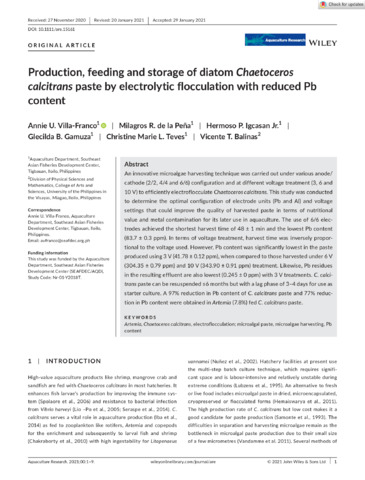Production, feeding and storage of diatom Chaetoceros calcitrans paste by electrolytic flocculation with reduced Pb content

View/
Request this document
Date
2021-03-02Author
Page views
291Metadata
Show full item recordCited times in Scopus
Share
Abstract
An innovative microalgae harvesting technique was carried out under various anode/cathode (2/2, 4/4 and 6/6) configuration and at different voltage treatment (3, 6 and 10 V) to efficiently electroflocculate Chaetoceros calcitrans. This study was conducted to determine the optimal configuration of electrode units (Pb and Al) and voltage settings that could improve the quality of harvested paste in terms of nutritional value and metal contamination for its later use in aquaculture. The use of 6/6 electrodes achieved the shortest harvest time of 48 ± 1 min and the lowest Pb content (83.7 ± 0.3 ppm). In terms of voltage treatment, harvest time was inversely proportional to the voltage used. However, Pb content was significantly lowest in the paste produced using 3 V (41.78 ± 0.12 ppm), when compared to those harvested under 6 V (304.35 ± 0.79 ppm) and 10 V (343.90 ± 0.91 ppm) treatment. Likewise, Pb residues in the resulting effluent are also lowest (0.245 ± 0 ppm) with 3 V treatments. C. calcitrans paste can be resuspended ≤6 months but with a lag phase of 3–4 days for use as starter culture. A 97% reduction in Pb content of C. calcitrans paste and 77% reduction in Pb content were obtained in Artemia (7.8%) fed C. calcitrans paste.
Suggested Citation
Villa-Franco, A., de la Peña, M. R., Igcasan Jr., H. P., Gamuza, G. B., Teves, C. M. L., & Balinas, V. T. (2021). Production, feeding and storage of diatom Chaetoceros calcitrans paste by electrolytic flocculation with reduced Pb content. Aquaculture Research , 52(7), 3148-3156. https://doi.org/10.1111/are.15161
Subject
Taxonomic term
Collections
- AQD Journal Articles [1215]


